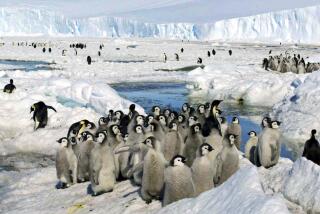Antarctic Food Chain in Peril, Study Finds
- Share via
Krill -- the heart of the rich Antarctic food chain that nourishes whales, seals and penguins -- have declined by more than 80% in the last 25 years in key ocean regions, according to a new study that links the loss to warming temperatures.
The new research, published in today’s issue of the journal Nature, is the first comprehensive attempt to estimate numbers of the small, shrimp-like creatures that once were so abundant that their swarms colored vast patches of the southern oceans blood red.
Now, krill have largely been replaced by salp, clear, gelatinous invertebrates that provide so little nutrition to predators that they are considered ecological dead-ends, said Angus Atkinson, a marine biologist with the British Antarctic Survey who led the study.
Such a steep decline in krill could decimate the region’s abundant wildlife, ecologists said.
The finding may signal that a shift is underway in one of the world’s most productive and pristine ecosystems.
“We’re just holding our breath to see what the consequences are,” said William Fraser, an Antarctic researcher who was not involved in the current study.
Antarctic krill are thumb-sized crustaceans that feast on drifting phytoplankton and in turn provide food for myriad Antarctic denizens, including the blue whale -- the largest animal on the planet.
Atkinson and his colleagues pooled data from nine nations that collected krill in Antarctic waters.
Because krill are a “boom-and-bust” species that varies dramatically in number from year to year, the group looked for long-term patterns.
The international team found krill numbers had decreased by more than 80% since 1976 in the southwest Atlantic near the Antarctic Peninsula, a hugely productive marine area thought to be a krill spawning ground and home to about half of the region’s adult krill.
The area has warmed in the last 50 years by 4.5 degrees Fahrenheit, nearly five times the global average, the researchers said.
Some scientists link the warming to natural climate cycles; others say that the production of greenhouse gases, such as carbon dioxide, plays a role as well.
The result is a diminished ice cover in some parts of the waters surrounding Antarctica. Krill larvae require sea ice to survive the winter. Young krill eat algae that grows in cracks on the underside of the ice and hide in the cracks to evade predators.
Without sea ice, the larvae starve, said Fraser, who has studied Antarctic penguins for three decades and now heads the nonprofit Polar Oceans Research Group in Sheridan, Mont. “Sea ice is the heartbeat of Antarctica.”
The Antarctic Peninsula is thought to have seen heavy ice years more often in the past. More recently, these “good” ice years have occurred only about once every five years. Since krill live six to seven years, they can still get in one good reproductive year even if ice is sporadic.
Fraser said if good ice years occurred too far apart, the krill would not be able to successfully reproduce.
“What you would see then is a literal collapse of the food web,” he said. “All the predators would suffer some pretty drastic declines.”
He pointed to the Adelie penguins, which eat only krill during the summer months. Their numbers in the Antarctic Peninsula have declined by 70% since 1974.
A loss of krill also could restrict the rebounding of whale populations, which are still recovering from extensive hunting that pushed them close to extinction.
Some scientists, however, are skeptical of the study’s conclusions.
Krill expert Steve Nicol of the Australian Antarctic Division questioned whether Antarctic krill, with a biomass once estimated at more than 1 billion tons, were really down by such enormous numbers.
“Could we really have lost 900 million tons of krill without anyone noticing? I don’t think so,” he said. “You would expect to see most of the predators in decline, and that doesn’t appear to be happening.”
He said the krill could be greatly underestimated because of the difficulty in tracking the creatures as they migrate and are tossed about through the vast seas. The krill may have moved deeper because of changes in ocean circulation or because ultraviolet light is now blasting surface waters under the Antarctic ozone hole, he said.
It is also possible that the rebounding populations of whales are gobbling krill at higher rates, and the loss of sea ice may not be to blame.
“Something’s happened,” Nicol said in a telephone interview from Tasmania.
“We’re just not quite sure what.”
More to Read
Sign up for Essential California
The most important California stories and recommendations in your inbox every morning.
You may occasionally receive promotional content from the Los Angeles Times.













